How I got to know a gun owner one shot at a time

Maggie Martin keeps Heather Bushman at ease as she gears up. The gun expert is cool under pressure
September 6, 2024 | story by Heather Bushman | photos by Carly Blum
Only four days after meeting Maggie Martin, I find myself strapped to the passenger’s side of her Ford F-150, barreling toward what I think is probably a bad decision.
We’re headed for Martin’s family farm in Bronson, a small town of 1,200 people on the edge of Levy County. Light conversation fills the car as Martin makes her way down increasingly dusty roads, but the closer we draw to our destination, the more nerves reverberate around my chest.
I’m off to do something I’ve never done before and, for a long time, swore I’d never do. A mix of fear, guilt and hesitant excitement finds a home in the pit of my stomach, but I try to push it aside.
It’s not hard with Martin, 36, in the car. She’s kind, open, bubbly and vivacious. She’s classically pretty, with long, shiny brown hair and a face usually accentuated with aviator glasses or large diamond earrings. A bright smile and pleasant laugh light up her features.
Martin’s a talker, so distraction comes easily at first. We start by discussing her truck — the door of which sports bruises and craters following a recent hit-and-run — and move to pleasantries until the elephant in the vehicle becomes unavoidable.
Excitement starts to slip through the cracks in Martin’s collected demeanor, like she’s about to let me in on a huge secret.
“Are you excited? Are you nervous?” she asks.
Yes, definitely. More than I’d like to admit.
“Did you tell your parents?”
I grow a little pale.
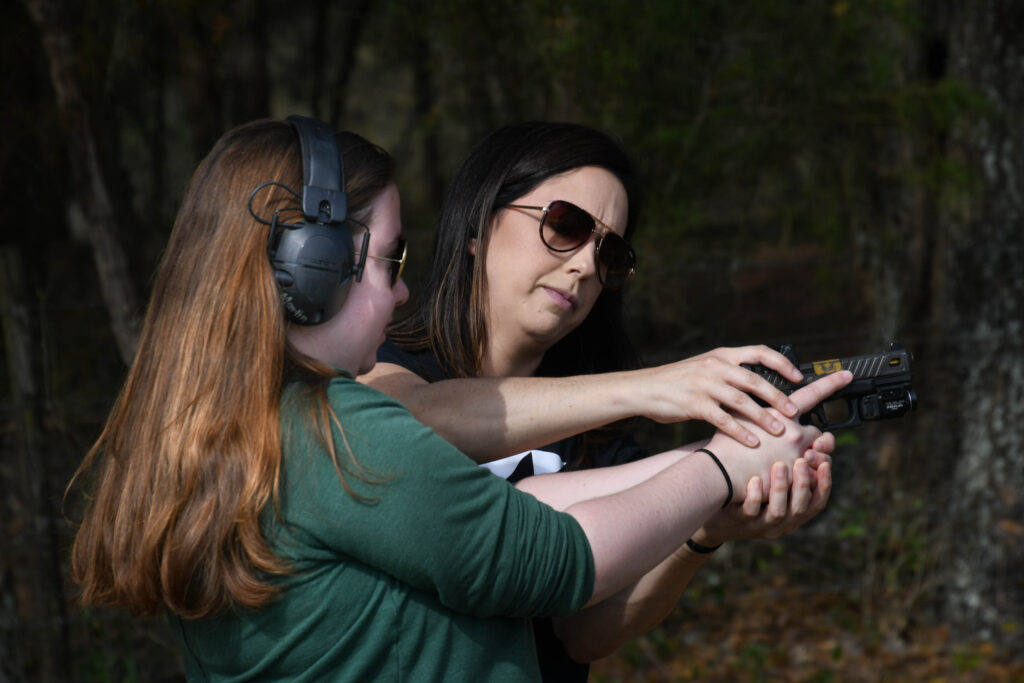
Martin corrects Bushman’s grip as she prepares to fire a few rounds.
I’m going to shoot a gun for the first time. Martin, a licensed gun instructor, will give me a brief lesson on safely wielding and using a firearm on her private range.
My household was never firearm friendly, so the prospect is alien and, frankly, frightening.
Despite my St. Johns County roots — where more than 36,000 residents have a concealed weapon license, according to the Florida Department of Agriculture and Consumer Services — I didn’t grow up around guns. Some friends’ parents owned them, but they were tucked away on high closet shelves, concealed from conversation and our curious young eyes. I have no knowledge of them aside from the flashes of devastation I’ve seen them create and the disappointed shake of my mother’s head that always follows.
So no, I have most definitely not told my parents.
I laugh that question off instead of giving Martin a straight answer. To my relief, she lets it slide. We continue the drive down County Road 337, commercial centers bleeding into quiet suburbs and eventually giving way to a sprawling countryside. The fields seem to stretch forever. Rustic farmhouses dot every property. We’re only about 20 minutes from town, but I feel as if I’ve entered a separate civilization.
The Martin family farm finally comes into view through the truck’s windows. The vision is breathtaking. A late-afternoon sun hits the plains just right, painting the green grass with an intense orange hue and casting all 220 acres in a golden glow. In the distance sits a white manor atop a grassy peak — a literal house on the hill.
Martin reserved a corner of the property for her humble range, which consists of a small shed, an awning and a dirt mound about 15 yards away. She recruited friends and family to help her build it, and she spent her 20s shooting away stressors and breakups.
Truck in park, Martin asks if I’m ready to start.
Truthfully, I’m not sure, but I say yes anyway. It echoes when she asked me if I wanted to do the lesson at all four days ago — and how I ventured into this story in the first place.
I had a basketball coach whose catchphrase has never left me: “Be comfortable being uncomfortable.” He probably meant it for the court, but I took it as a challenge in all areas of my life, especially in journalism.
The topic of guns isn’t even in the same area code as my comfort zone, but with such salience in national headlines, I knew I had to give this story a shot. Pun intended.
Discourse on gun reform still dominates the news, and pleas for tightened restrictions resurface after every all-too-common mass tragedy. Gun opponents dispute the humanity of supporters, wondering how they sleep at night knowing they keep close the capacity to kill.
I heard my mother ask that same question so many times.
“I just don’t understand,” she lamented. “Why would someone own a gun?”
That question, I decided, was worth an answer. I researched Alachua County’s gun landscape, hoping to immerse myself in some aspect of the culture and community. A few Google searches led me to A Girl and A Gun, a women’s shooting group with a chapter in Gainesville.
One Facebook message prompted a phone call early on a Wednesday afternoon.
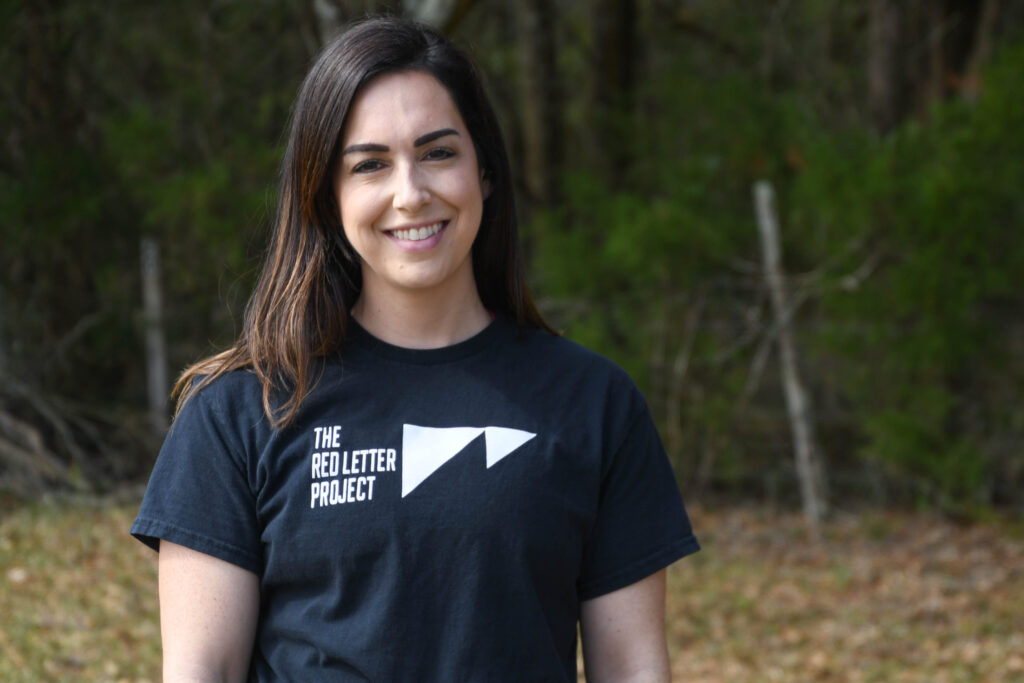
Martin’s shirt bears the logo of the Red Letter Project: a group that combines the gun community and the Christian faith. The Red Letter project offers group retreats and training sessions on gun safety — something Martin is particularly passionate about.
The woman said her name was Maggie Martin, and she’d love to be part of the story. We arranged to meet at a Starbucks on 43rd Street that Friday.
I ran late that morning by two or three minutes, but when I entered, Martin was already settled with a cup of coffee. Obligatory hellos exchanged, we dove right in.
My guard was up immediately. All I knew of girls with guns was a readiness to shoot at a moment’s notice and a take-no-crap attitude advertised by sassy stickers decorating the backs of big trucks and intimidating Instagram posts. Open dialogue with a gun owner was new to me, so I expected a strong Southern accent and even stronger opinions. I was half ready for Gretchen Wilson’s “Redneck Woman” to play through the Starbucks speakers.
Martin squashed my misconceptions fast. I wasn’t speaking with a camo-clad country product; in front of me was a former cheerleader, the prom queen, the person “most likely to brighten your day” among Oak Hall’s class of 2005. This wasn’t a trigger-happy tough girl with a chip on her shoulder — just someone who obsessed over the Prince Harry and Meghan Markle docuseries like everyone else.
In fact, the two of us had a lot in common: Martin graduated from the University of Florida with a degree in public relations, which is in the same college as my journalism degree. We bonded over shared classes and swapped stories about the grammar lessons that never left us.
Much like me, Martin didn’t grow up loving guns. Her dad taught her to skeet shoot at her family’s farm, but Martin looked at guns as weapons meant to kill, as agents of chaos.
She didn’t start to see guns differently until she turned 30 and a former boyfriend gave her a handgun as a gift. That relationship ended, and finding herself living alone for the first time, Martin signed up for private lessons to learn how to use her new gun. First, it was only a hobby, but a bad online dating experience upped the ante, ending in a police report and Martin fearing for her life.
He was everywhere, a looming threat that chained Martin to constant fear. She avoided the side of town where he lived and kept an eye over her shoulder. Eventually, even home started to feel unsafe.
This is how I die, she thought.
News stories and statistics screamed at her to do something about it. Headlines flashed with horrific tales of women dying helplessly, violently taken by men they trusted. Almost 1,100 women and girls in the U.S. are killed by an intimate partner each year, according to a study from the Violence Policy Center. Martin didn’t want to be part of that number.
The story of a girl whose mother had to listen to her die at the hands of her boyfriend stuck, spurring Martin to take ownership of her safety. So she stepped up, devouring any self-defense expertise she could find. First it was concealed weapons, but Martin dabbled in jiu-jitsu, mixed martial arts, knife fighting and more.
Now, Martin is a shooter — a great one, she says, with unapologetic confidence that took years to earn. She’s a licensed gun owner, and Florida concealed carry laws allow her to keep a weapon with her everywhere she goes. She spends her free time at the range refining her skills or mentoring other shooters, mostly women, to create a community of queens who straighten each other’s crowns.
Martin is a teacher as much as she is a student, a combination of extroversion and an entrepreneurial spirit lending her to leadership. She operates her own handgun instruction enterprise under MDM Tactical and will soon take over Gainesville’s chapter of A Girl and A Gun.
As she recounted her knowledge on the Starbucks patio, I wasn’t sure whether to feel completely safe or scared out of my mind. Across from me was a highly skilled, highly capable self-defense expert who could probably pin me to the ground in five seconds. But Martin could also take down someone who threatened us, and for some reason, that was pretty comforting.
That’s the point, Martin told me. The GLOCK19 she keeps secured around her waist and the years of training is a security blanket, a tool. If, God forbid, something were to happen, she’d be ready.
She identified all the possible attack points from where we sat like Genie pointed to the exits on the magic carpet in “Aladdin.” Suddenly, I was all too aware of our surroundings.
Is this the burden of knowledge Martin carries? I wondered if Martin’s preparedness ever bleeds into paranoia, if she lives with the fear of imminent danger looming and a tendency to always watch her back. Is she ready to pull the trigger at the first sign of a fight?
Martin answered my question before I could ask it. If someone were to try to rob the Starbucks where we sit, Martin wouldn’t stop them.
“Really?” I said.
“Yep, unless somebody has pointed a gun and is about to mow down all of these people,” she answered.
It clicked then: Martin’s no Batman. There is no gun-owner code that obligates them to jump into action at the first sign of danger, no law that states they have to beat up the bad guys like the caped crusader would. She’s more like Spider-Man, or at least Uncle Ben: With great power, Martin knows, comes great responsibility.
As I spent more time with her, I realized she shares several attributes with the GLOCK 19 she keeps concealed in her waistband. They’re powerful, quick, decisive. They’re both small in stature but not to be underestimated, both capable of doing some serious damage. The GLOCK is only 7.36 inches in length, and Martin stands at just 5-foot-2.
One key takeaway stands out among their similarities. There are rules — lots of them.
She walked me through the gun rules on multiple occasions, repeating them like a sacred script. Number one: Always assume the gun is loaded. Two: Never point the gun at anything you don’t intend to shoot, including parts of your body. That leads to three: Place your finger on the trigger only when you’ve located a target and fully intend to fire. And four: Always be aware of your foreground and background, lest your bullet flies somewhere it isn’t supposed to.
The personal rules appear more discreetly, in little sayings she drops in our conversations. Give it to God (He will never take something away without replacing it with something greater). Buy local produce if you can. Make sure your friends get home after a night out. Never leave your safety up to anyone but yourself.
Martin is regimented above all. She can’t say the same for everyone else.
She learned that lesson the hard way when her quest for instructor certification sent her to Mayo, a no-man’s-land 90 minutes east of Tallahassee. Here, Martin spent two days with a group of instructor hopefuls just like her, eager to prove their skills through a series of drills and assessments.
The class’s final test required the participants to shoot 16 rounds within a 12-inch target from 15 yards away. Except it didn’t.
The instructor allowed the class to stand only five yards back. He addressed his students conspiratorially.
“Everyone saw everyone shoot at 15 yards, right?”
No, Martin thought.
He repeated himself: “Everyone saw everyone shoot at 15 yards, right?”
It dawned on Martin then that her peers there didn’t have the same regard for rules that she does. The class was an exercise in cutting corners, culminating in certifications tossed like confetti.
OK, Martin thought. I guess that’s how we’re playing this.
The rude awakening told Martin her tactical approach is a bit of a rarity in the gun world. If gun ownership exists on a spectrum, Martin lies on the extreme end of safety.
A study from the University of Washington’s School of Medicine estimated only 61% of gun owners nationwide receive any formal training. Martin’s trying to change that, starting with her students.
Her passion and persistence are enough to convince me I should be one of them. When Martin offered me a private lesson at the end of our first meeting, I couldn’t say no.
Four days of clueless preparation — including a few unfortunate Google searches of “what to wear to a gun range” and “does shooting a gun hurt” — did little to quell my anxiety, but Martin’s patient explanations on the way to the range helped a little.
She’s coached me all the way there, explaining the anatomy of the gun in detail and walking me through how the lesson will look. By the time we step outside the truck, I almost feel comfortable.
Martin switches into teacher mode immediately — collected, patient, confident. I see her bubbly energy level out under the mask of professionalism, no less kind but all the more serious as she unloads her equipment and begins our lesson.
Her bag, emblazoned with stickers declaring “don’t call me sweetheart” and “BAMF,” may as well be a bomb with how meticulous Martin is in unpacking it. She treats the objects like a game of operation, like if she puts them in the wrong place a bright red buzzer will blare around us. If we’re following the first of Martin’s four commandments, the one about the loaded gun, this may as well be true.
Those sacred rules come soon after Martin’s assembled her equipment. I’ve heard them so often in our short time together I can almost repeat them myself.
Then it’s time. We gear up — noise-canceling headphones fastened, eyes protected, hair tied back — and trek to the dirt mound that will see the business end of our bullets. Martin sets the target, which is nothing more than a piece of paper stapled against a cardboard square, in front of the mound. She counts five paces backward.
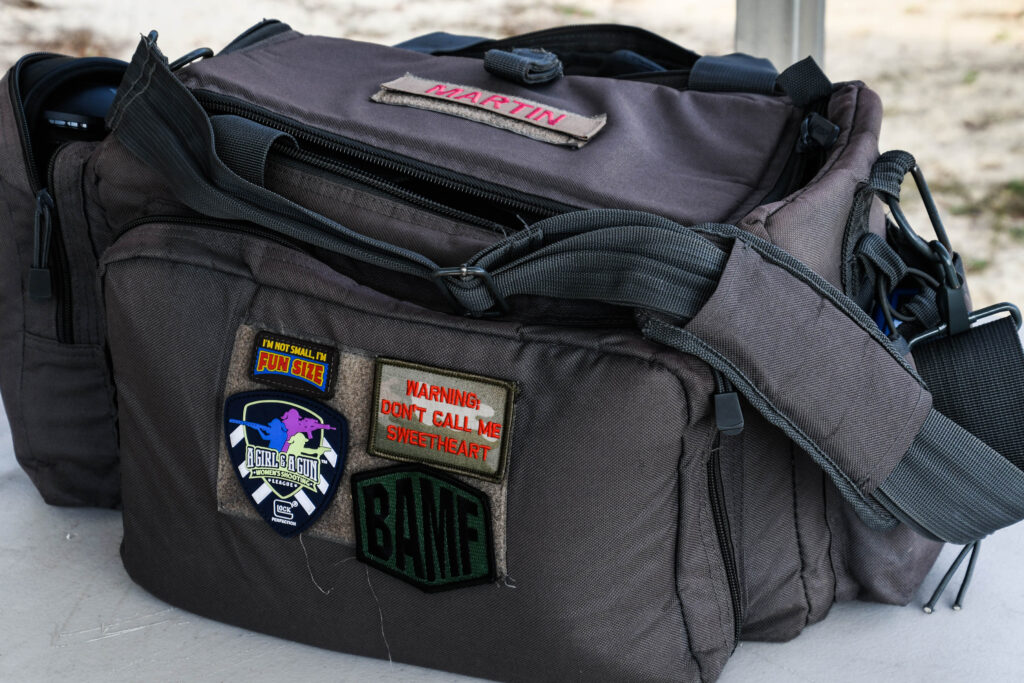
Martin’s bag is emblazoned with decorative patches. The slogans and sayings speak as much to her tough demeanor as they do her sarcastic, playful side.
First, we dry fire, where I am to draw and fire the gun unloaded to get a feel for the motion. As expected, it’s a process with protocol: grip, trigger press, sight and stance.
Martin demonstrates with practiced ease — unholstering the gun, cocking it back and aiming it arrow-straight at the target in one fluid motion. She cuts through the air with such poise that I let myself believe maybe it won’t be so hard.
Then she hands her trusty companion to me. Oh, how wrong I was.
If Martin is the Michelle Kwan of dry firing, I’m that scene in “Bambi” where the poor calf stumbles and fumbles around the frozen pond. The second the gun settles in my hands, it feels awkward, unnatural. The size and shape are all wrong, and I can feel my body rejecting it.
I yank the stubborn slide back for that satisfying click and spend too long lining the elusive red dot with my target. Finally, my finger presses back on the trigger, but it doesn’t take an expert to determine that my first try was sloppy.
The second attempt goes better than the first, the third better than the second, and the fourth is the best yet. Martin decides I’ve done well enough to move on to the real deal. She loads the gun in preparation.
I’m fine until I’m not. Loud noises, I remember, are not my strong suit — a fact that had conveniently slipped my mind until Martin pressed the trigger. If I was nervous before, that’s nothing compared to the paralysis that takes over my body at the sound of that first shot.
A fun fact about the sound of a gun going off: It’s not a bang. It’s a crack — crisp, narrow, resolute. The explosion is over before it starts, but the split second is enough for my breath to catch.
The remnants of it ring through the range, echoing like falling fireworks before fading into nothing. I’m still ringing too, the sound of my heart pounding in my ears like Martin’s shot on repeat. The noise-canceling headphones do nothing to help. If anything, they amplify the nerves.
Martin fires a few more times. Concentration etches her face as she zeroes in on her target, and a barely-there tinge of satisfaction crosses her features as she hits the mark every time.
I’d be content to stand back and watch her assault the X in the middle all day, but suddenly, it’s my turn. My breaths grow shallow and uncertain.
I can’t fire a gun, not with the risk of recoil or a rogue bullet. Not with my shaky hands that will surely drop it when it goes off. Not with the ear-splitting crack. I’ve never even held a gun before, much less shot one. What was I thinking?
Martin’s assured me time and again that the choice to shoot is mine, that I can always say no, but I feel I’ve backed myself into a corner I can’t escape from.
Martin notices.
“Do you want to take a break?” she asks.
Yes, please. But no. Or not quite. I’m stuck.
I want to abandon the idea altogether. Because I’m holding a gun, because I’m scared and because, on some subconscious level, I feel like a monster.
Guns have brought worlds of grief, loss and destruction. They’ve been at the heart of some of the greatest national tragedies — Aurora, Charleston, Pittsburgh and Uvalde. In Florida, remnants of the Marjory Stoneman Douglas High School shooting still linger, a traumatized community in its wake. Almost 3,000 Floridians die each year from gun violence, according to a Centers for Disease Control and Prevention report, and Florida only sits at No. 29 on the list of gun deaths by state.
But I want to do this. Because I’ve come all the way out to the range to chase the other side of the story, because it would be embarrassing to duck out now, because I want to feel what Martin feels — the adrenaline, the assurance, the pride.
Guns have yielded a sense of self for women like Martin and her students. They’ve inspired a personal responsibility and done wonders for her self-esteem. Through shooting, Martin has found a strong system of support and mentorship that’s carried her into independence. Guns, apparently, can create as much as they can destroy.
I decide that’s too intriguing of an idea to pass up, and if pursuing it means trusting a mechanism of plastic and metal and a pinch of gunpowder for a few seconds, then so be it. I decline the break.
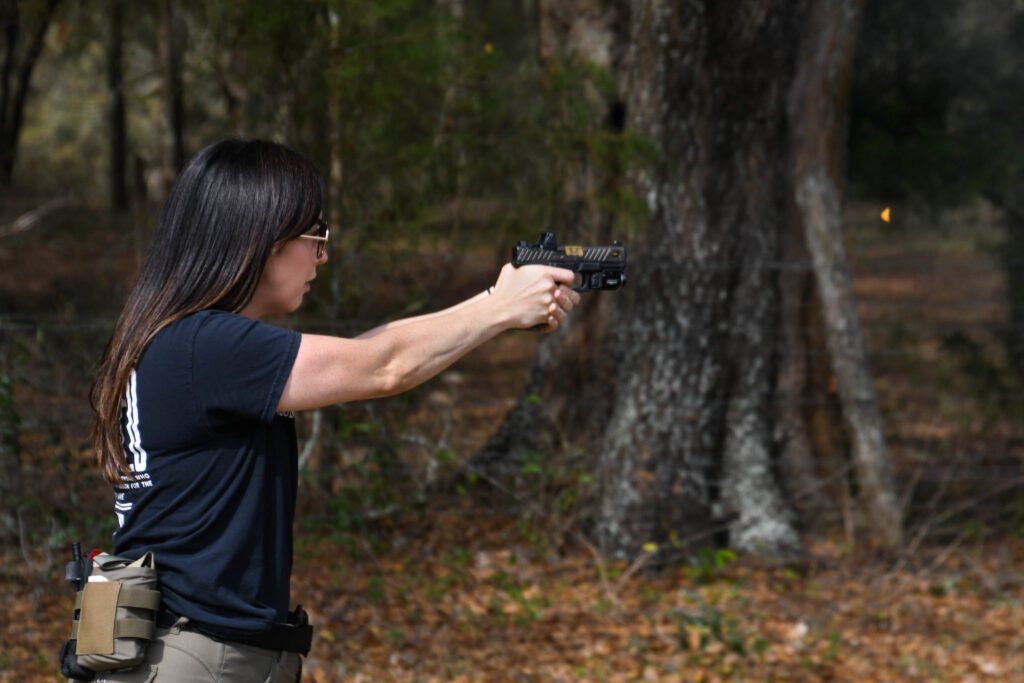
Martin’s grip on her gun never falters — even as the press of a trigger creates a kickback effect
The rules set in. Take up as much “real estate” — or space — on the gun as possible. Grip it so tightly your hands almost shake. Locate the red dot in the sight of the gun on the target. Point it only toward your intended target. Press — don’t pull — the trigger.
“You can do this,” Martin assures me. I want so badly to believe her.
I follow Martin’s detailed instructions to the word. I take up the real estate. I grip the gun until my hands shake. I locate the red dot and line it up with the target. I raise the gun.
I breathe.
I press the trigger.
It’s only a split second, but in the moment where the bullet flies toward the target, a spark of accomplishment emerges. I’ve chipped away at a longstanding hesitation, and though part of it remains, there is satisfaction in knowing I’ve conquered a fraction of the fear. I’m not sure I’ll ever touch a gun again, but I’m proud to say I’ve done it at all.
It fades as quickly as it flashed, sheer relief replacing it as I take my trembling finger off the trigger and lower the gun with unsure arms.
“Take a deep breath,” Martin instructs gently.
We assess my first shot together. Martin smiles at me, and I can’t help but let the ghost of a grin slip through.
Bull’s-eye.
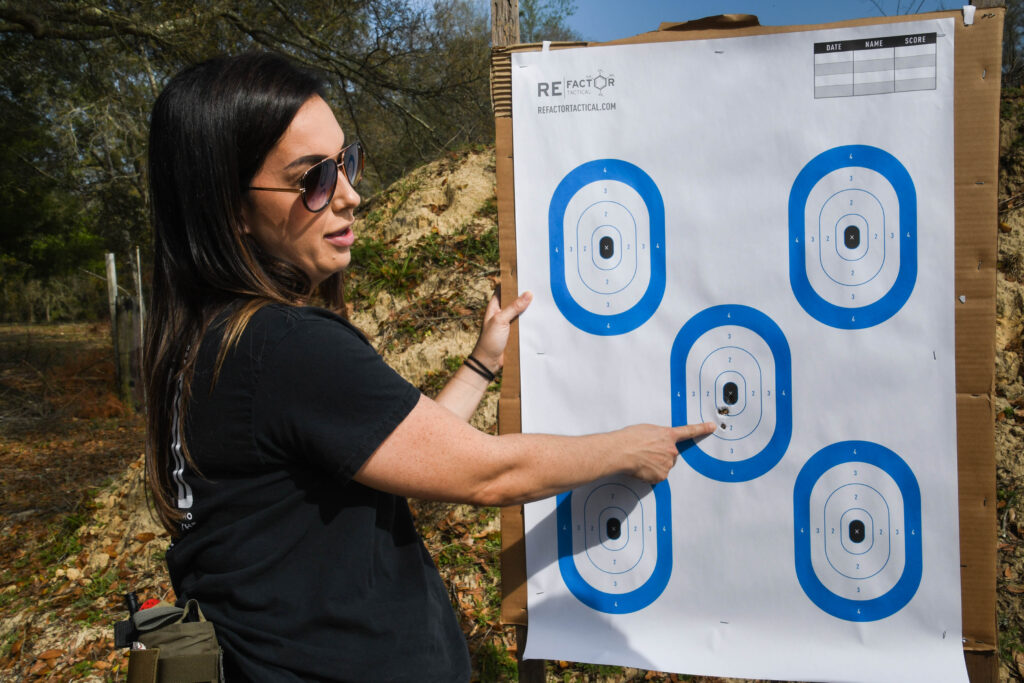
Martin assesses Bushman’s performance on the paper target. Not bad for a rookie.